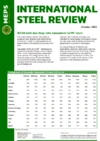US long steel product prices to rebound in 2025
US steel prices for rebar and wire rod are expected to rebound in 2025 after dropping by around 40% since their May 2022 peak.
While rebar and wire rod prices remain 22% higher than in January 2020 – prior to the Covid-19 pandemic – prices are expected to rebound in the first half of 2025. Stronger construction spending, due to a reduction in interest rates and an end to uncertainty resulting from the US presidential elections, are expected to lift steel demand and US long product prices.
Donald Trump’s election as the 47th US President presents an upside risk to MEPS’s near-term US steel price outlook. If higher import tariffs are quickly implemented, supply could be reduced, causing larger price increases than those currently forecast. Mexico, the United States’ second-largest source of long product imports, is particularly exposed to the risk of increased tariffs.
- Regular insight from the United States steel market is featured in MEPS's International Steel Review. The monthly report features steel prices, price indices, market commentaries and forecasts. Contact MEPS for details of how to subscribe.
Downward pressure on US prices
Weak demand, ample supply and moderating scrap steel prices were the key reasons for the recent price drop. Housing starts dropped to 1.35 million (annual rate) in September from a peak of 1.83m in April 2022, curtailing steel requirements.
Raised interest rates and residential property prices have reduced buyer interest. In November 2023, 30-year mortgage rates rose to 7.8% from a recent low of 3% at the end of 2021, according to the Federal Home Loan Mortgage Corporation (Freddie Mac). This followed the US Federal Reserve’s raising of interest rates – starting in 2022 – from 0% to 5.25%. The Fed’s recent move to lower rates, with a 0.5 percentage point cut in September and further reductions – totalling 1.5 percentage points – expected over the next 12 months, should be good news for steel demand.
The release of funding from 2021’s Infrastructure Investment and Jobs Act (IIJA) has also been slower than expected, providing little impetus for steel demand this year. According to the US Department of Transportation, only 30% of the IIJA funds have been committed to projects, leaving a significant share available for the next few years.
In a recent quarter three earnings call, Nucor chief executive Leon Topalian said: “While we recognise that new infrastructure spending has been less deal intensive than originally expected, we do still expect to generate incremental demand in the years ahead.” Rebuilding efforts in the Southern states affected by recent hurricanes will also support demand in the coming months.
Increased import volumes have also dampened price support this year. Raised domestic steel prices at the start of the year encouraged a flow of imports in the first half of 2024, with peak levels in April and May. US imports of long products grew 37% year-on-year in May. Falling domestic prices have since reduced buyers’ appetite, however, and year-to-date imports of long products were down by 1.6% at the end of September. Given the current, subdued levels of demand, domestic supply has been sufficient to meet buyers’ demands.
Finally, reduced scrap prices have played a role in weaker long product prices. Shredded Midwest scrap prices were reported at USD380 per tonne in October, a significant decline from the USD452 per tonne price recorded at the start of the year. Given stable-to-lower steel production rates expected until the end of the year, scrap prices should remain near USD400 per tonne into December.
Improved levels of demand forecast
Due to lacklustre demand and stable scrap prices, US long product prices are expected to remain fairly flat for the remainder of 2024 with rebar and wire rod prices remaining near to their current level. MEPS US steel forecasts expect prices to begin rising in 2025, peaking in April 2025. In addition to decreasing interest rates and reduced uncertainty, federal government investment programmes will support US steel demand in 2025.
Limiting some of this price growth will be new capacity that is scheduled to come online in 2025, particularly for rebar products. Steel producers, including Nucor, CMC and the new market entrant Hybar, are expected to add more than 1.5 million short tons of capacity by 2025.
Speaking at a conference earlier this year, Hybar chief executive Dave Stickler said that the steelmaker’s 630,000 short ton plant in Arkansas is scheduled to begin production in 2025. He added that the company had already sold 25% of its annual production for the next 10 years.

Source:
International Steel Review
The MEPS International Steel Review is an essential monthly publication, offering professional analysis and insight into carbon steel prices around the world.
Go to productRequest a free publication





